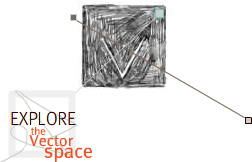Nation on the Move
Design by Erik Loyer
Designer's Statement
Interfaces are often marketed as filters that help to distinguish signal from noise in an information-saturated environment. They enable us, we are told, to reveal messages that would have otherwise been hidden in clutter; they allow us to make information more appealing by removing traces of the things which disinterest us.
In Nation on the Move, our goal was the opposite: instead of rendering complicated things simple, Minoo Moallem and I wanted to trouble simplicity with disorder. Over the course of the piece, a single thread is pulled, teased and stretched into a chaotic web of interconnections between ideas of nationhood, gender, commerce and art that comprise the world of the Persian carpet. At the heart of the work is an acknowledgment of the essential impossibility of "sorting out" these relationships into some well-defined hierarchy.
Paradoxically, this rhetorical strategy is the result of careful interpretation of the extreme orderliness of the database which drives the project. This database is comprised of "panels" defining each image and video clip the user sees. Each panel contains active locations called "sites" at which one or more pieces of content may live. Each piece of content is then assigned a thematic "thread" which ends up being rendered as a literal thread in the visual presentation. As the user progressively reveals the content of the piece, these threads become more and more jumbled.
The chaotic trajectories of the threads arise from two factors. The first is that our foundation visual element is the image, which we treat as a 2D landscape containing short texts at specific locations suggested by the image content. Since the individual images have no relationship to each other in their composition, the texts end up being laid out in a fashion which appears almost random. The second factor is the visual persistence of the threads, which are constrained to pass through the location of each bit of content to which they are linked. The combination of these elements ensures that once the user has explored a majority of the images she will be faced with a tangle of threads anchored by content which seems to be laid out at random.
The seeming chaos of the piece is thus quite designed, as it often is in the digital realm. Unlike the physics of disarray we're accustomed to encountering in the physical world, in the digital world content creators are frequently cast in the role of entropic agents, adding measured amounts of chaos in an attempt to hit the "sweet spots" of human perception. To see a visual representation of the order which the project transmutes into chaos, take a look at the project's interactive index, an experiment in making the underlying structure of Vectors projects more accessible to the general public. The index is a graphical browser of the Nation on the Move database in which individual elements can be bookmarked for review or citation purposes. Our hope is that features like the index and the project's video tutorial will help bring greater transparency to our practice and product.



